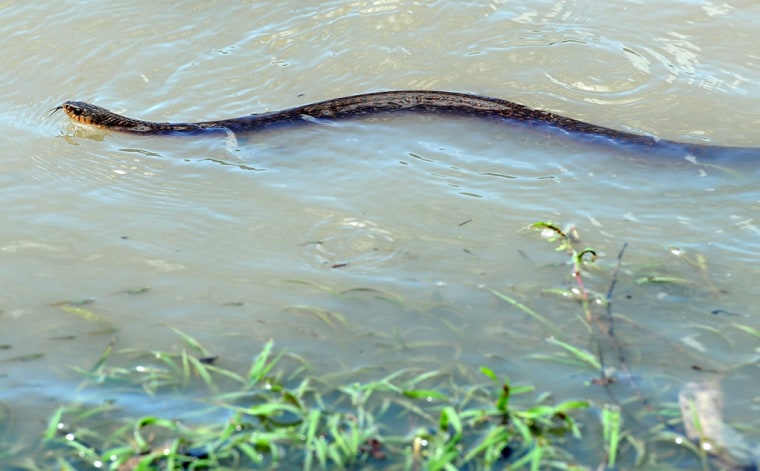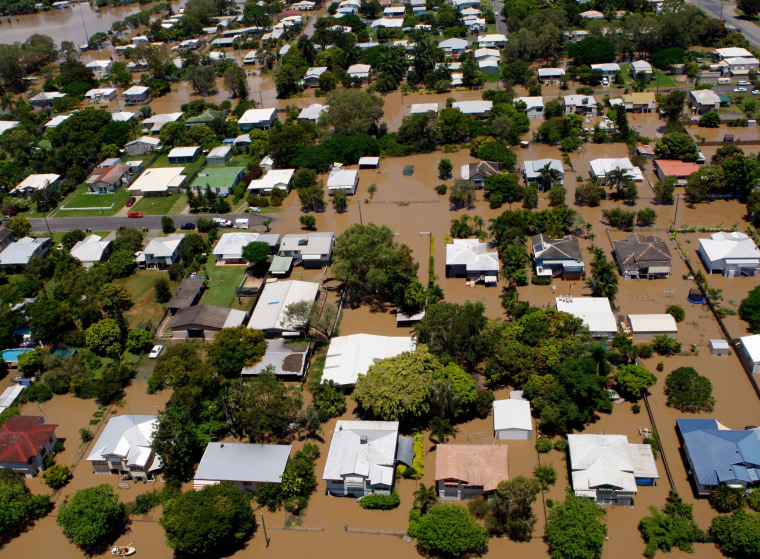Weary residents of a flooded Australian coastal city braced for water levels to peak Wednesday, as state officials held an emergency meeting to help determine recovery plans for the 200,000 people affected by the deluge.
More than a week of pounding rains has left much of northeastern Australia under a sea of muddy water that is making its way through river systems toward the ocean.
The swollen Fitzroy River was expected to reach the second-highest level on record Wednesday in the largest affected community of Rockhampton before finally beginning to subside. Local media reports have said that 400 homes may be inundated, and the river could remain above flood levels for at least a week.
The Fitzroy has already spilled over its banks, inundating houses and businesses in Rockhampton in waters covering the city streets ranging from a few inches (centimeters) to waist-deep. Up to 500 people who live along the river have evacuated their homes. Air and rail links to the city of 75,000 people were cut and only one main road remained open.
The flooding was already having an impact on Queensland's economy, ruining crops and closing most mines.
Floodwaters had made it impossible for 40 of the state's coal mines to operate, ministers said at an emergency Cabinet meeting in the Queensland capital Brisbane on Wednesday.
"It's going to take some months for some mines to be back to full operation," Resources Minister Stephen Robertson said. "We earn 'round about AU$100 million ($100 million) a day exporting coal to the rest of the world and exports have been significantly restricted by the impact on infrastructure."
In other parts of the state, some flooded communities were beginning to dry out. In the town of Theodore, which evacuated all 300 residents last week, specialists arrived in helicopters on Wednesday to check the safety of power, water and sewage plants, county Mayor John Hooper said.
Officials were still trying to determine when it would be safe to allow residents to return. One problem: an influx of venomous snakes, flushed from their habitats and searching for dry ground amid the waters.
"I'm hearing stories that it is bad," Hooper said. "And I've been told they're (the snakes) bloody angry, so people will have to be very careful."
Rockhampton residents have also reported seeing higher than usual numbers of snakes, Rockhampton Mayor Brad Carter said. Saltwater crocodiles were another worry for people entering floodwaters, as the predators have been spotted from time to time in the Fitzroy River, Carter said.
"There's a lot of snakes — and I mean a lot," Rockhampton resident Shane Muirhead told Australian Broadcasting Corp. "Like, every hundred yards (91 meters) you will see a snake, and they're just everywhere."
A total of 22 cities and towns in Queensland have been swamped by floods that began building just before Christmas — the worst effects of an unusually wet summer in the tropical region. Swollen rivers and flooding have killed 10 people in Queensland since late November, police say.
Officials have said the flooded area covers the size of France and Germany combined and 200,000 people have been affected.

Authorities have warned residents to stay out of floodwaters for their own safety, saying the biggest risk is from fast-moving currents powerful enough to sweep cars from roadways. At least two people have drowned after being swept away in their cars.
Prime Minister Julia Gillard has said the cost associated with the flooding will likely reach many hundreds of millions of dollars, and has announced relief funding worth millions.
Rains have eased, and water levels have been dropping in some Queensland communities. Across the state, some 1,000 people are living in evacuation centers, and it may be a month before the floodwaters dry up completely.
Despite the devastation, Carter said the residents of Rockhampton were keeping their spirits up.
"We have a very resilient community," Carter said. "They're holding up very well. Many of the people that live in these low-lying areas have been through these flooding events before."
U.S. Secretary of State Hillary Clinton sent a condolence message to those affected by the floods and said Washington was ready to help if needed.
"Our thoughts and prayers are with everyone affected by these floods, especially the families of the victims, and with all the people of Australia," Clinton said in a statement distributed by consular officials.
A military cargo plane landed in a city north of Rockhampton on Monday carrying food, water, medical supplies and other items such as diapers to keep the city stocked with necessities. The goods were trucked south to the city, or carried on barges. Further flights would continue as needed, acting Defense Minister Warren Snowdon said. Two navy helicopters were on standby to help.
Other supplies were being brought by sea from areas south of Rockhampton, where regular supply routes may be closed for days to come.
